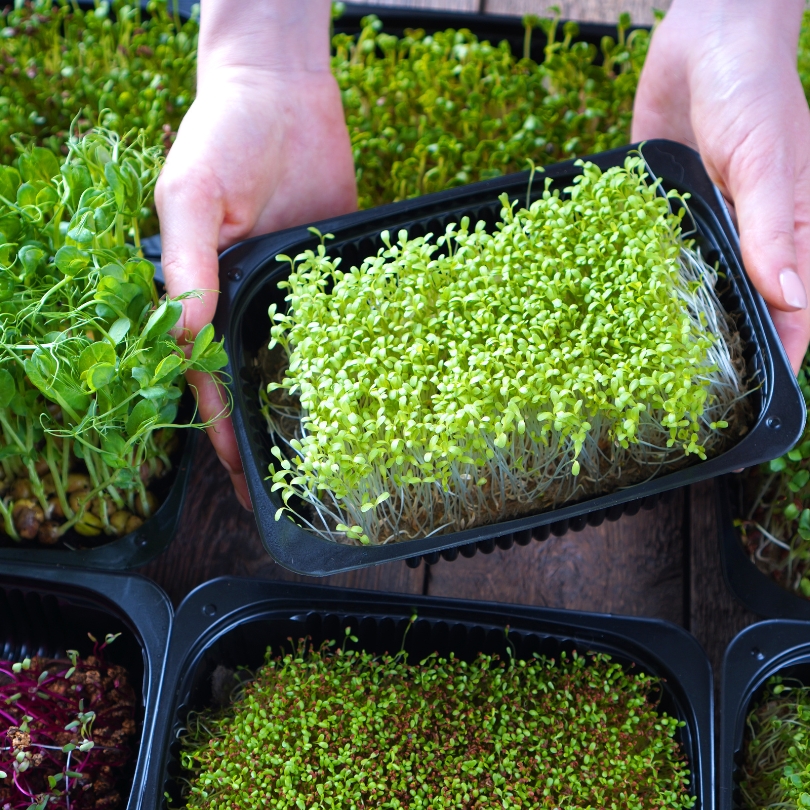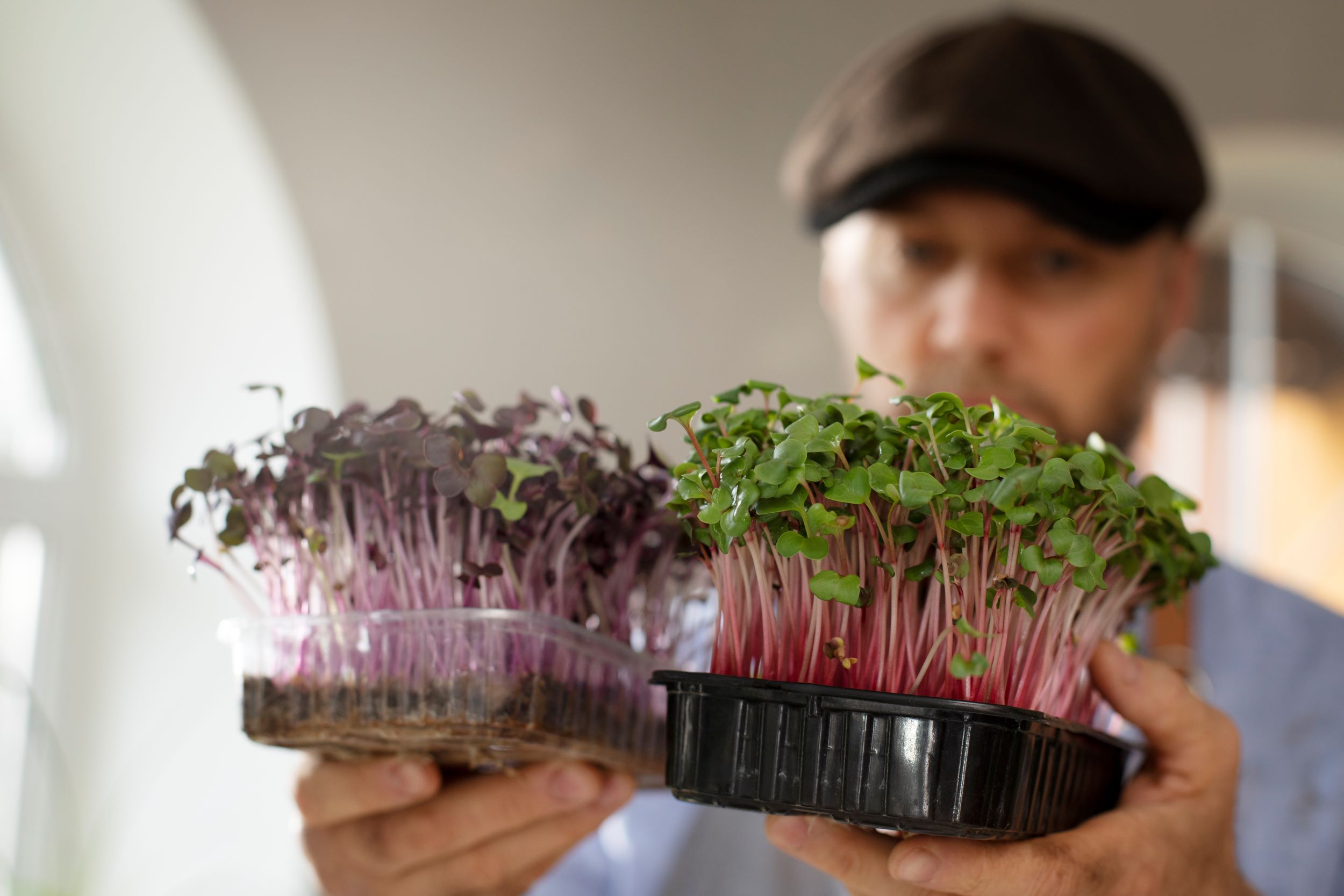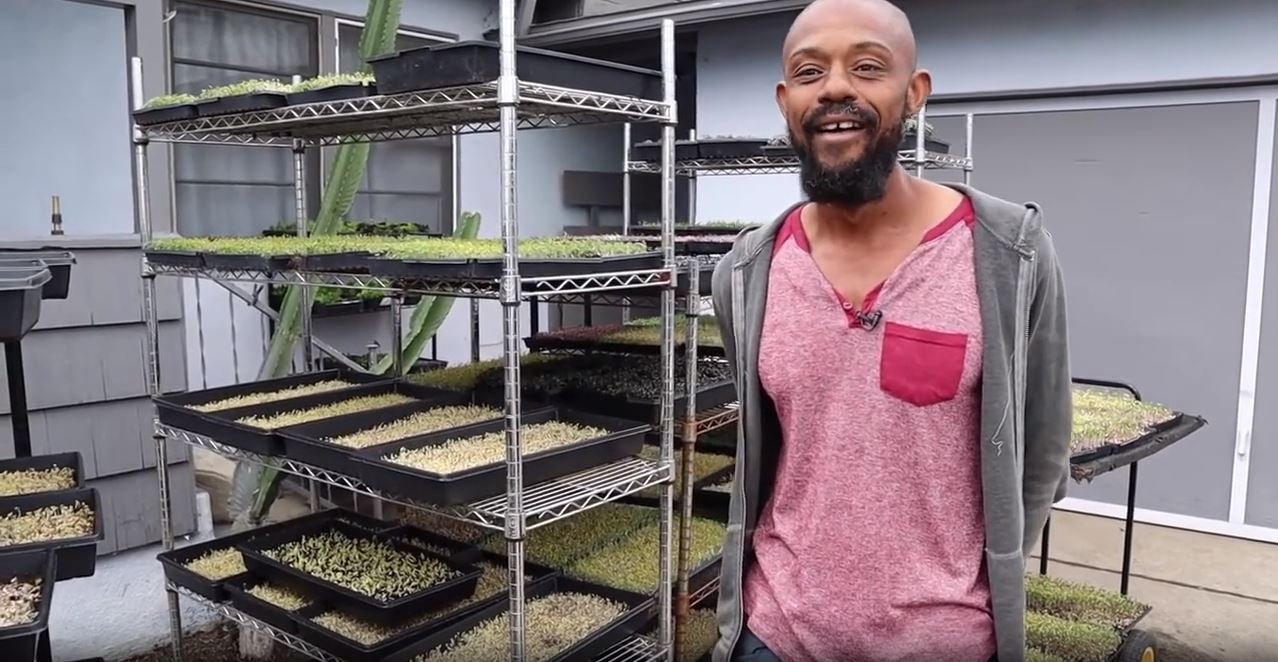Starting a microgreens business is a dream for so many of us, but going from hobby to full-time work is where things get real. You’ve likely asked yourself “when is the right time to make this my career?” This is the story of how we made that transition with our own microgreens farm, covering the financial planning, challenges, and lessons learned along the way.
Our journey began five years ago, with some trays in the basement and visions of a little greenhouse. I was working a regular office job back then, so mornings were for nurturing our baby greens before heading off to work. The plants didn’t care what time we checked on them – 6am or 6pm, they grew just the same.
But over time, as things picked up, there just weren’t enough hours in the day. Mornings came earlier and client meetings later. We reached a turning point where we had to seriously think about whether this could be a real, full-time business, not just a passion project.
Going all-in was scary, I’m not going to lie. Losing that steady paycheck felt risky. But we set tangible financial goals, made a plan, and took the leap of faith into full-time microgreens farming.
In this guide, I’ll share our personal experience transitioning from side hustle to career. The money stuff, the challenges we faced, and the lessons we learned that might help you decide when to make the jump. Because at some point, you have to choose whether to keep your microgreens venture a passion or give it the space to really grow.
I hope our story provides a realistic look at what it takes. Through the highs and lows, may it help you make the right choice in taking your microgreens business full-time.
Knowing When the Time is Right
The first step in going full-time with a microgreens business is realizing when the timing is right. For us, it was a mix of outside factors and inner signs all pointing towards taking the leap. Our early morning microgreens sessions got earlier and earlier, soon creeping past midnight. The joy of growing was getting lost in the rushed race against the clock.

Reading the Signs
Our part-time gig was demanding more than a sliver of time – it needed our full focus. The hints were clear, from cutting the morning routine close, to glancing anxiously at the clock, to just feeling drained. The final straw was mornings becoming a mad scramble with no room to breathe, plan, or grow. And no time to meet potential clients, a must for building the business.
Limited Client Outreach
Working 9-5 really limited our ability to schedule meetings and develop the business outside mornings and weekends. Things plateaued; our growth stalled out. Lack of time wasn’t just a feeling – it was a real barrier to progress.
This all signaled our microgreens venture had outgrown its part-time status. It was ready to spread its roots but needed more than those early morning hours – it needed our full dedication.
Not being able to book meetings, feeling rushed off our feet, seeing progress halt – these were the catalysts that pushed us to consider going all-in. Looking back, the universe was nudging us towards unlocking the potential of our microgreens biz.
As you walk a similar path, keep in mind that spotting these signs and aligning them to your life and finances is crucial for a successful microgreens business. Recognizing the right time means listening to the whispers of your business and the realities of your daily life.

Making the Money Work in Your Microgreens Business
Going all-in on microgreens brings some big money questions. Trading a stable paycheck for an uncertain but rewarding new business revenue stream is tough. For us, leaving fixed income was scary but growing our business was the dream.
Understanding the Impact
First, we had to honestly look at the numbers. Losing my dependable $70-80k salary for the unknown of entrepreneurship was a hard reality. But we had to look past the immediate loss of potential earnings if we gave the business our full focus.
Setting Goals for Your Microgreens Business
Our goals went beyond just replacing our salaries – we wanted to thrive. We mapped out a plan for the client numbers we’d need monthly not just to get by, but hopefully exceed our past earnings. It was detailed, aiming to prosper through the transition.
Personal vs. Business Finances
We had to separate personal and business money. My paycheck could no longer count as household income, but became a business investment instead. This let us clearly see how sustainable our business was on its own, not propped up by external funds.
Doing the money homework was huge. It showed where we stood and what it would take to get to stability and growth through microgreens. Most importantly, it gave us a financial lens to see the path ahead – less scary and more structured.
Getting Ready for Go-Time
Deciding to go all-in on a microgreens business isn’t something you do overnight. For us, it took lots of talks, planning, and mapping things out. Here’s how we prepared for lift-off:
1. Ensuring Financial Security
Before leaving our jobs, we needed a safety net. Saving up from the 9-5 alongside microgreen revenue created a cushion for the unknown ahead. Having those savings eased the money stress of transitioning.

2. Separating Personal and Business Funds
We made a clear division between personal finances and business money. This let us accurately gauge our business standing on its own merits, not muddled with personal obligations. The clarity was enlightening and empowering, showing the financial roadmap.
3. Setting Aside Investment Capital
We started seeing our full-time salaries as investment capital for the microgreens business. Shifting perspectives let us direct funds into growing and expanding the microgreens venture. It enabled investing in key resources like marketing to ease the transition.
4. Crafting a Business Plan for Your Microgreens Business
Having a detailed plan provided a roadmap forward. It covered our model, projections, marketing, and growth goals. Referring to it gave a structured approach to reach the targets we’d set.
5. Making Early Customer Connections
Before leaving our jobs, we started engaging potential clients, laying the groundwork for future partnerships. Getting the word out early helped establish valuable local connections for post-transition.
6. Seeking Entrepreneurial Advice
Talking to others who made the leap gave us invaluable insights. Hearing their experiences, challenges and advice painted a realistic picture of the road ahead for our own prep.
Preparing meant having a solid plan, clear money strategy, and a support network in place. It was about anticipating challenges and readying solutions. Looking back, taking time to prepare not only smoothed the transition, but also gave confidence embarking on full-time microgreen business.
Taking the Leap
After countless talks, number-crunching, and prep work, we found ourselves at the doorstep of a massive choice – keep balancing my job with the business or take the plunge into full-time microgreens farming. It was a rollercoaster of excitement and anxiety, each feeding the other, pushing us towards decision time.
Discussing as a Family
This career shift impacted more than just us, so we had open conversations with family about how it would change our lifestyle, money, and future. Their insights, concerns and support were key to making an informed choice.

Mental Preparation
Getting our heads ready was just as crucial as the financial prep for our microgreens business. Adapting to new routines, facing uncertainties head-on, and staying driven through challenges required mental toughness. We visualized our future life and got ready to manage what was coming.
Evaluating Risk vs. Reward
Carefully weighing the potential downsides against the benefits was instrumental. We looked at worst case scenarios next to best ones, getting realistic on the spectrum ahead. This helped set proper expectations for the risks and payoffs to come.
Seeking Outside Opinions
Talking with financial and business pros gave invaluable perspective. Their expertise helped refine our plans, ensuring we were on the right track and mitigating areas of concern.
Finalizing the Financial Plan for Your Microgreens Business
By this point, we had a rock-solid financial plan accounting for different scenarios. This gave us security and sustainability making the full-time transition.
Having the Tough Talks
Candid chats with employers were emotional. Giving notice and picking an end date closed one chapter and sparked a new one. Their support and understanding eased the process, allowing us to move on respectfully.
Deciding took an emotional marathon of talks, research and prep. It meant aligning passion with practicality. As we leapt in faith into our full-time microgreens business, a reality sank in – we were headed into a new dawn of possibilities and entrepreneurial freedom.

Embarking on the Microgreens Business Adventure
Leaving steady jobs for the thrill and uncertainty of full-time microgreens growing was like entering a new world. Handing in our resignations closed one chapter and sparked a whole new journey. Here’s how our leap of faith unfolded:
1. Turning in Notices
Quitting was nerve-wracking yet freeing – a tangible step towards pursuing our passion full-time. Our employers’ support eased the leap into the unknown.
2. Adjusting Financially
The first months of our full-time microgreens business brought an income dip. Our financial cushion was crucial to navigating it without panic. It was an adjustment period – learning new money dynamics and working towards our goals.
3. Confronting Challenges
Challenges were many – increased workload, maintaining quality and delivery. Each was a lesson, honing skills, teaching business nuances, and prepping us for the road ahead.
4. Embracing the Learning Curve
Every day brought new lessons – microgreens intricacies, client interactions, financials – the learning curve was steep but enriching.
5. Celebrating Small Victories
Celebrating wins kept spirits high – landing a new client, great feedback, hitting a money milestone. Each win fueled our leap of faith.
6. Evaluating and Tweaking
Regularly reviewing performance against plans was key. It showed our progress, what worked, what didn’t, and where adjustments were needed.
7. Building a Client Base
Gradually our customers grew. Time invested in engagement and quality began paying dividends, laying the business foundation.
8. Savoring Freedom
Despite challenges, the freedom to pursue our passion, make business decisions, and see our dream grow brought immense fulfillment.
The leap of faith meant embracing the unknown with a plan and hope. It was facing obstacles resiliently, celebrating small wins, and always learning. As we cleared those early hurdles, our vision kept us focused on building the thriving microgreens business we dreamed of, through entrepreneurship’s ebbs and flows.
Reviewing Our Decision
Going from part-time to full-time microgreens growing wasn’t just a schedule change – it reshaped our lifestyle, goals, and dreams. As we dove into entrepreneurship, evaluating our choice became integral, helping us understand the impact and results.
Reflecting on Business Growth
Our decision proved its worth in our venture’s growth. Within 6 months our revenue doubled, exceeding our past full-time incomes. It affirmed the potential our business had, once we went all in.

Analyzing Personal Fulfillment
Beyond money, the personal fulfillment from following our passion was priceless. The freedom to explore, nurture our farm, and make choices brought accomplishment no 9-5 could match.
Assessing Lifestyle Changes
The transition also meant lifestyle shifts – more family time, flexible schedules, and being our own bosses. Despite the workload, the flexibility and satisfaction were rewarding.
Receiving Feedback
Insights from clients, family and peers were invaluable. They highlighted our strengths, areas for improvement, and our products’ impact.
Understanding the Financials
Continually evaluating financial health was critical. It provided visibility into our planning, strategy effectiveness, and business sustainability.
Learning and Adapting
We used the evaluation to learn from experiences, understand the market better, and adapt accordingly. It enabled continual refinement to stay aligned with goals.
Evaluating Work-Life Balance
Ensuring a healthy work-life balance was essential. We looked at how the routine impacted personal life and what adjustments were needed.
Planning for the Future
The evaluation also enabled future planning. Analyzing our current standing, growth potential and gaps helped create a roadmap forward.
Evaluation was not just a retrospective – it laid the foundation for our future. It helped grasp the impact of our decision, benefits gained, and lessons learned. This phase instilled a deeper understanding of entrepreneurship, preparing us for the long microgreens journey ahead.

Growing the Team
As demand boomed, it became clear we needed to scale up. Managing everything alone was becoming impossible. Here’s how we navigated hiring and expanding:
1. Identifying Resource Needs
The growing workload and customer base showed we needed more hands on-deck. We had to scale while ensuring consistent product quality and customer satisfaction.
2. Hiring Managers and Farmers
Bringing in experienced managers and farmers not only eased the load but provided new perspectives and expertise. Their input and help were invaluable for streamlining and boosting productivity.
3. Delegating Responsibilities
Learning to delegate was a curve. It involved entrusting tasks to others, while maintaining oversight on quality. Freeing up time enabled more strategy and business development while building a culture of trust.
4. Investing in Tech and Equipment
Scaling up meant upgrading technology and equipment to meet demand. Investing in modern farming tools and software significantly improved our efficiency and output.
5. Expanding Clientele and Reach
With a solid team, we could grow our market presence – marketing campaigns, farmers’ markets, local restaurant partnerships. This helped broaden our customer base and establish stronger footholds.
6. Maintaining Quality and Satisfaction
Amidst scaling, upholding microgreen quality and customer satisfaction was paramount. Regular client feedback and ongoing quality checks helped meet standards.
7. Evaluating Financial Health
As we grew, monitoring financial health, return on investments, and sustainability of scaling efforts was crucial.
8. Planning Future Expansion
Scaling up provided insights into future challenges and opportunities, aiding plans for further expansion. Growing involved balancing challenges, learning, and growth. It meant maintaining our essence while adapting to a growing business. With each step, our vision of a thriving microgreens farm came into focus, affirming the importance of continuous improvement, learning, and change in entrepreneurship.
Key Takeaways and the Road Ahead
Our journey from a basement startup to a thriving microgreens business was filled with pivotal lessons, each experience imparting wisdom we carry forward:
1. Embracing Change
The transition to a full-time microgreens business taught the importance of embracing change, whether adapting to new routines or evolving our model to meet market demands. Being open to change was key for growth.

2. Learning from Mistakes
Mistakes, while tough, were fair teachers. Every misstep provided insights that honed our decision-making and problem-solving for future obstacles.
3. Building Relationships
Establishing strong relationships with clients, vendors and stakeholders was foundational to our success. They fueled business growth and created a supportive community.
4. Investing in Continuous Learning
This industry evolves rapidly. Staying updated on trends, technologies and market dynamics was crucial. Investing in skills proved beneficial.
5. Financial Prudence
Exercising financial prudence, especially early on, helped navigate uncertainties during the full-time transition.
6. Valuing Work-Life Balance
The importance of maintaining work-life balance became clear through experience – it sustains entrepreneurial spirit and personal well-being.
7. Looking Ahead with Optimism
Moving forward, we’ll expand our horizons, explore new markets, and continuously evolve to meet changing demands. Our lessons cultivated a realistic yet optimistic outlook for our microgreens business.
8. Sustainability and Community
Engaging our community and pursuing sustainable farming are future goals for our microgreens business. We aim to contribute positively while ensuring our venture’s sustainability.
Our journey shows the endless possibilities for aspiring microgreen farmers – hopes, challenges, victories and constant learning. As we nurture our green oasis, the dream of contributing to a greener, healthier community keeps us motivated to grow in this ever-evolving world of microgreens.
Our Microgreens Business Journey in Summary
Our wild ride from part-time enthusiasts to full-time microgreen farmers has been filled with invaluable lessons and growth. Every phase – from early mornings in the basement to bustling days on the farm – has been an experience of learning and evolution.
The transition was about more than just changing schedules – it meant embracing uncertainties, evolving mindsets, and nurturing our entrepreneurial drive.
Taking Calculated Risks
Leaping into full-time farming was a calculated risk backed by planning and tenacity. It showed the power of taking chances when armed with a solid strategy.
Leveraging Passion
Our passion for microgreens fueled us even on tough days. The love of what we do has made the journey rewarding despite the challenges.
The Value of Preparation
Preparation provided a sturdy foundation to navigate uncertainties. It went beyond logistics to ready us mentally and emotionally.
Community and Support
Support from family, friends, and our community was a pillar of strength, encouraging us to persevere when times got tough.
Continuous Growth and Learning
Each day brought new lessons. An ethos of constant learning and adaptation has been central to our success.
Looking to the Future
Moving forward, our dreams are bigger, goals higher, and commitment stronger. Expanding our microgreens business, contributing to our community, and promoting sustainability will guide the journey ahead.
Our story is about following passion, embracing entrepreneurship, and tireless growth. We hope it inspires aspiring microgreen farmers to take the plunge with careful planning and pragmatic passion. As we grow our green horizons, these experiences enrich our odyssey, encouraging us to explore, learn and flourish endlessly.




